Part 1: Seminar Report
copyright © 2012 Douglas Tong, all rights reserved
For the published online version of this report, go here.
______________________________________________________
On July 15 & 16, 2012, we had the unique opportunity to host Kajitsuka Sensei in his first seminar in Canada. This landmark event took place at Dragon Fencing Academy in Richmond Hill, Ontario.
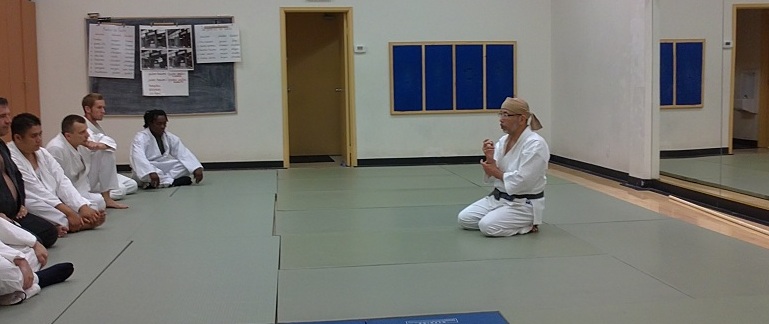
Sensei talking to the students about Yagyu Shingan Ryu
On the morning of the first day, he introduced the group to the art of Yagyu Shingan Ryu Taijutsu. He talked about the history of the style and traced its origins back to the founder, Araki Mataemon, who was connected to Yagyu Munenori. He also discussed the existence of the two current branches of the art, the Sendai-Line and the Edo-Line and how that division came about and its consequent effects on the ordering and categorizing of the techniques and katas within the schools.
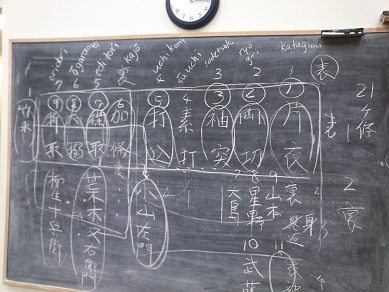
Sensei’s written explanation of the waza and kata
When put in this historical context, it was easy for the students to see how the art evolved and how the existence of the two lines came into being. Heady stuff, yes, but necessary in order to put things into context. When we next examined and practiced the basic techniques of the style, it made perfect sense. We could see the logic inherent in the categorizing and ordering of the waza. As one student put it:
The techniques we learned in both Kenjutsu and Jujutsu in the seminar were subtle and impactful, similar to Kajitsuka sensei’s personality and teaching style. It was definitely a truly memorable and eye opening experience. I wish to thank Kajitsuka sensei for his willingness to not only share the techniques of his style but for giving us the insight, the purpose, and meaning behind these techniques.
Joel A.
Markham, ON
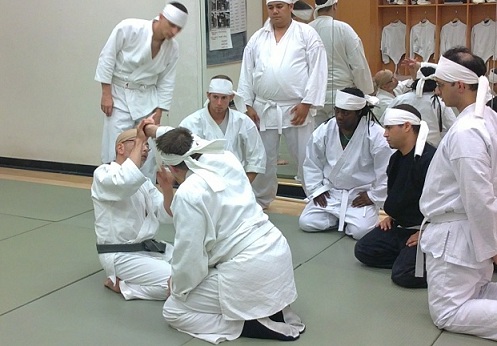
Soke explains about various joints, pressure points, and nerves
In the afternoon, the group continued to practice the basic principles of the style and their attendant waza and kata. The members were then given a treat when Kajitsuka Sensei presented each participant with their very own hachimaki, the headband used in Yagyu Shingan Ryu. Sensei then went over the purpose, the tradition, and the uses of the hachimaki.
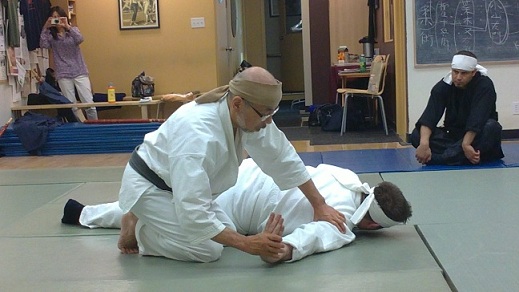
Soke demonstrates a take-down and submission technique
He then reviewed all that was done that day with each student personally, one-on-one, while everyone watched (mitori-geiko). He wanted to make sure every student had gotten them right. Having just arrived the previous night at 1:00 am and getting perhaps 3 hours sleep, then working hard all morning teaching and finally being thrown a total of more than 200 times by the 10 participants plus all the joint manipulations and take downs, we were all amazed at Soke’s stamina and fortitude. Simply amazing is the only word for it.
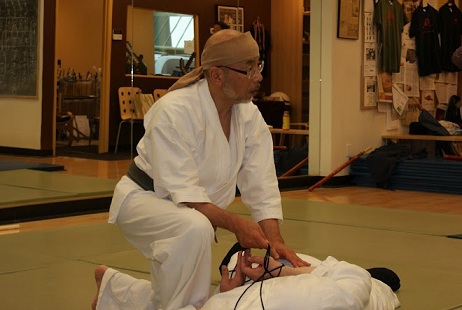
Sensei explains some of the intricacies of how to tie the rope (tying methods of hojojutsu)
Kajitsuka Sensei then finished off the seminar with a fascinating demonstration of hojojutsu*, the art of restraining a prisoner with a rope. Here, the students saw it all come together: the use of jujutsu to take down and submit the prisoner, and the use of hojojutsu to restrain and arrest him.
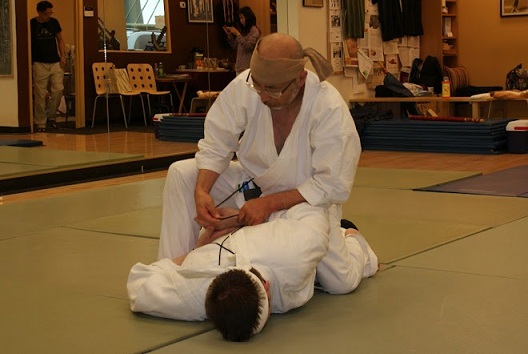
Soke demonstrating hojojutsu
After the seminar, we had a special ceremony where Kajitsuka Sensei presented each participant with a personalized shikishi, on which was written a saying, a piece of philosophy, or a principle from Yagyu Shingan Ryu or Yagyu Shinkage Ryu. Having gotten the list of attendees from myself and having seen their technique and spirit, he gave each participant some words to live by or some piece of philosophy to think deeply about, to guide them in their training or in their approach to budo and life in general. Each one was unique. The students were deeply touched by this personal gesture from Soke. It was a fitting end to a memorable first day. We all then went out to share in a nice dinner together.
Here is what one student had to say about the first day:
Dear Tong sensei,
First off, let me thank you sincerely for your efforts to bring Kajitsuka sensei to Canada and give us the opportunity to share his budo with us.
The seminar with Kajitsuka sensei was above our expectation. He was speaking in Japanese but we didn’t have any problem understanding his message or the techniques. So far, that is the best seminar I have ever attended. We started with Taijutsu; He gave us some historical background. He emphasized the importance of Ukemi and what is a Koryu Ukemi. One thing I liked is that Sensei played the Uke for each of us and despite his age, his ability and toughness is unbelievable. He took us through Kata 1 with its 5 applications. He explained to us Reiho etiquette and how to use the headband. We finished with Seiza techniques and their applications, and then he answered our questions.
This seminar just opened my eyes to want to further study this system. I definitely want to train more with Kajitsuka sensei.
Mohammed B.
Richmond Hill, ON
The second day focused exclusively on Yagyu Shinkage Ryu kenjutsu. We have been patiently building our group since 2008, and we were eager to show him what we had accomplished. Kajitsuka Sensei opened our eyes further to the beauty of the art: its subtlety, its power, its finesse, and its strength.
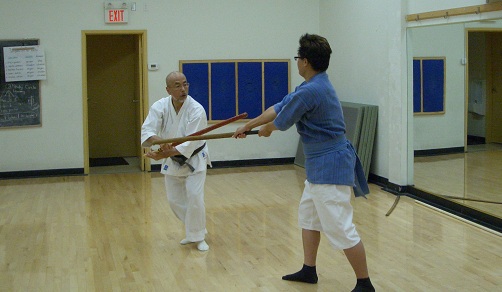
Kajitsuka Sensei demonstrating Yagyu Shinkage Ryu with Mr. Tong
There were only 10 participants in each seminar. We purposefully kept our numbers low because we wanted to keep the experience genuine. It cost a little more for each participant but it was well worth it. They got a first-class experience: training with the soke, up close and personal. He got to know them and they got to know him.
Kajitsuka Sensei practiced with each student, one by one, over and over, in both seminars. He watched their paired practice too, and offered personal advice to each student.
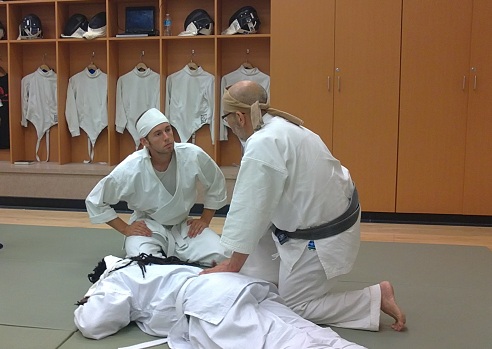
One of the participants getting personalized one-on-one attention and advice from Soke
And at the end of the second day, we all sat down together after the seminar to talk and share experiences and ask him the questions about the two arts that the students had long thought about. We all had a great time talking about budo, Japanese history, philosophy, Japanese culture, and of course, Yagyu Shingan Ryu and Yagyu Shinkage Ryu. We talked, we drank, we ate, and talked some more. We ended the day with gift-giving, speeches, toasts, and good-byes.
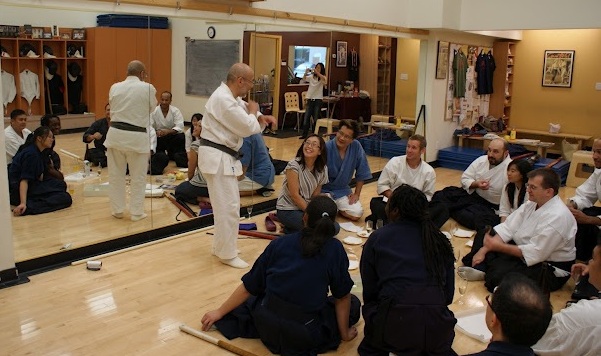
Sensei answering a student’s question during the post-seminar pow-wow
From what I heard from the students, they were amazed that Kajitsuka Sensei was so approachable. Some of the students had been to other seminars where the teachers were either put on a pedestal, where the ordinary students could not get close to them, or else, the teachers put themselves on pedestals, remaining unapproachable and aloof, preferring to maintain a certain distance from the students. The students were struck by how “down-to-earth” and friendly he was.
Here is what another student thought about the whole experience of training with Soke:
It was an extraordinary experience to get to meet Kajitsuka Sensei. I was really blown away by his knowledge and understanding of both Yagyu Shingan Ryu and Yagyu Shinkage Ryu. But even more than that, I was blown away by his humility, passion, and love for his “Ryuha”.
He is not just the “Soke”, but a true teacher and we were really lucky to have him teach us for the two days that he spent with us.
Daniel C.
Woodbridge, ON
The students got to know Kajitsuka Sensei in an intimate way that weekend and he got to know them personally. And that was the whole point of the seminar.
Hello Mr. Tong,
I just wanted to thank you personally for the opportunity to be taught by Kajitsuka Soke. It was a great privilege and an even greater honour to have been taught so much and in such a personal way. It was a tremendous eye opening experience for me. The time and effort you and your family put forth was remarkable. I just wanted to thank you once again.
Domo arigato gozaimashita,
Patrick G.
Scarborough, ON
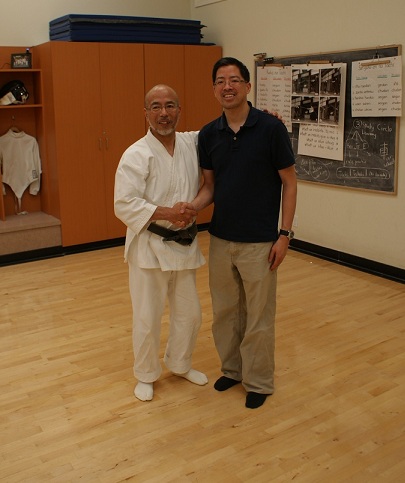
Making new friends (Kajitsuka Sensei with Stanley Yee, the owner and president of Dragon Fencing Academy)
All in all, it was a wonderful experience for everyone with many fine memories.
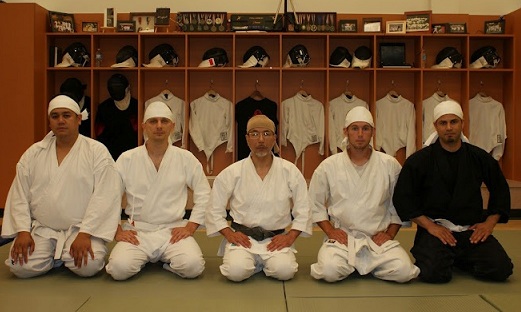
Sensei with a few members of the Yagyu Shingan Ryu seminar group (Toronto, 2012)
To watch Kajitsuka Sensei’s group perform Yagyu Shingan Ryu, see:
Yagyu Shingan Ryu Demonstration (Nihon Kobudo Shinkokai Embu)
______________________________________________________
More about Yagyu Shingan Ryu:
“Yagyu Shingan-ryu was created to be a battlefield art with a large comprehensive curriculum of weapons, and grappling techniques for use both while armored and unarmored. The techniques of Yagyu Shingan-ryu were therefore designed to eliminate an enemy quickly and effortlessly. The Yagyu Shingan-ryu is a comprehensive combat system, training several arts, including jujutsu, rope tying/arresting (hojojutsu), quarterstaff fighting (bojutsu), glaive fighting (naginatajutsu), sword drawing techniques (iaijutsu), and sword fighting (kenjutsu).
Yagyu Shingan-ryu Taijutsu (Edo-line) is directed by Kajitsuka Yasushi (11th Lineal Headmaster). This school is known for its close quarter jujutsu techniques. The techniques are based on body physics rather than brute strength. Some of the trade-mark maneuvers include pole-driving (dropping an opponent on his head), back breaking, and neck snapping. Although this style does not employ the wearing of armor during practice or exhibition, the techniques are clearly designed for combating an armored opponent.
Unlike modern Japanese budo, which was created for the masses and is largely sport oriented, kobudo (“ko” being short for koryu, meaning traditional or old) was designed for the warrior, whose sole purpose was to kill or be killed. Many of Japan’s modern budo have their roots in the Yagyu schools of combat. Morihei Ueshiba, the founder of Aikido, was a student of Yagyu Shingan-ryu. He received the rank of Shoden from a Shihan of the Edo-line of Yagyu Shingan-ryu. Likewise, Jigoro Kano, the founder of judo, trained under the seventh lineal-headmaster of the Edo-line (Yagyu Shingan-ryu Taijutsu), Masateru Ohshima…”
Source: Yagyu_Shingan_Ryu
______________________________________________________
Part 2: Reactions and Reflections
copyright © 2012 Douglas Tong, all rights reserved.
For the published online version of this report, go here.
______________________________________________________
In this article I want to look back at the various reactions we had to Kajitsuka Sensei’s landmark visit to Canada and to highlight certain experiences that we all shared during those two days. And hopefully through this analysis, you will all see what a wonderful teacher he truly is.
The techniques we learned in both Kenjutsu and Jujutsu in the seminar were subtle and impactful, similar to Kajitsuka sensei’s personality and teaching style. It was definitely a truly memorable and eye opening experience. I wish to thank Kajitsuka sensei for his willingness to not only share the techniques of his style but for giving us the insight, the purpose, and meaning behind these techniques.
Joel A.
Markham, ON
I want to focus on two things that Joel had mentioned, namely that Kajitsuka Sensei’s personality was subtle and impactful. He is right. Kajitsuka Sensei is quiet and calm. He doesn’t speak loudly. He speaks quietly, sometimes softly. You have to listen very carefully and maybe that’s not a bad thing. You pay more attention.
Kajitsuka Sensei is also a philosopher, a thinker. When asked a question, Sensei would consider the question deeply before answering. He is deliberate and in no rush. In other words, he is very patient. And when he gives his answer, it is well thought out and in many cases, quite philosophical.
Kajitsuka Sensei is subtle; he is not in your face. There is no screaming, no shouting, no berating, or raising his voice. He doesn’t get worked up or frustrated. How can we encapsulate the essence of his teaching style in a word? I would say gentle.
What about his teaching method? Kajitsuka Sensei says only enough for you to get you to the next level of your development. He doesn’t give too much to overwhelm you. But he also is not deliberately trying to keep you down or keep things away from you. Joel talked about Sensei’s willingness to share. Yes, we covered a lot of kata. We received plenty of explanations, plenty of instruction (technical and philosophical). But it wasn’t about collecting kata or getting all the information we could. That would be impossible, and impossibly rude as well. But it was more Sensei’s openness and generosity that was so impressive.
Hello Mr. Tong,
I just wanted to thank you personally for the opportunity to be taught by Kajitsuka Soke. It was a great privilege and an even greater honour to have been taught so much and in such a personal way. It was a tremendous eye opening experience for me. The time and effort you and your family put forth was remarkable. I just wanted to thank you once again.
Domo arigato gozaimashita,
Patrick G.
Scarborough, ON
Patrick makes note of learning in such a personal way. Coincidentally, I asked Kajitsuka Sensei about the class atmosphere in koryu budo during lunch one day. He told me that in old days, it was one-to-one since the number of students was so small. The one-on-one style is basically a personalized approach to teaching. Teacher to student: heart-to-heart. We saw that in the seminar. He did techniques with each student one-on-one. We did mitori-geiko also. When they were working with partners, he made it a point to watch each pair deliberately and then offer some bit of personal advice to each student.
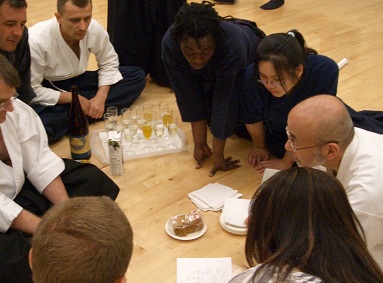
Teacher to student: heart to heart
I had remarked in Part 1:
After the seminar, we had a special ceremony where Kajitsuka Sensei presented each participant with a personalized shikishi, on which was written a saying, a piece of philosophy, or a principle from Yagyu Shingan Ryu or Yagyu Shinkage Ryu. He gave each participant some words to live by or some piece of philosophy to think deeply about, to guide them in their training or in their approach to budo and life in general. Each one was unique. The students were deeply touched by this personal gesture from Soke.
The personal touch was very evident. This was no 80-person seminar where you got lost in the shuffle, a situation in which one face blends into another. It was you and 9 other students and Sensei. He got to know each student. He practiced with each student. And, as the case of the shikishi indicates, he took a personal interest in each student.
At the end of the second day, we all sat down together after the seminar. This was a good chance to talk and ask Soke some questions about the two arts. It was an intimate setting.
The students found Soke very approachable. They asked him about the two styles. He talked about the history of the styles, the lineage and his place in it. The students also thought sensei was “down-to-earth”. He told us some funny stories about the times when he was a student under Mutoh Sensei. Old times, good times. Sensei was friendly and down-to-earth.
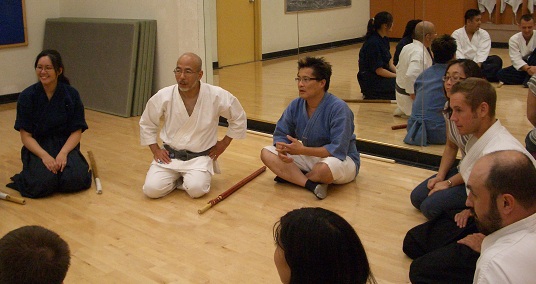
Post-seminar group discussion
It was an extraordinary experience to get to meet Kajitsuka Sensei. I was really blown away by his knowledge and understanding of both Yagyu Shingan Ryu and Yagyu Shinkage Ryu. But even more than that, I was blown away by his humility, passion, and love for his “Ryuha”.
He is not just the “Soke”, but a true teacher and we were really lucky to have him teach us for the two days that he spent with us.
Daniel C.
Woodbridge, ON
Daniel brought up some interesting issues. The first was the comment about Kajitsuka Sensei being a “true teacher”. I was puzzled so I later asked Daniel what he meant. He said that he felt Kajitsuka Sensei was a true teacher rather than one of those “ivory tower” teachers. The “ivory tower” headmasters and teachers are those that develop a big ego as a result of falling into the trap of thinking that they are somehow more special than everyone else. In his words, they come to believe that they are the enlightened ones as opposed to their students who are not. And this is what he meant when he sees them isolating themselves in their tower.
In contrast, Daniel told me:
“I just saw someone (Kajitsuka Sensei) come after a 22 hour flight (including a 10 hour stop-over), 2-3 hours sleep the night before, and have people literally throw him around all day long, and still spend the time with each student to make sure his teaching was well understood, and do so with extreme patience and understanding. That I think is the mark of a true teacher.”
For Daniel, that was a big lesson in what humility means in budo. Kajitsuka Sensei is also very humble. Sensei talks very quietly but as Joel said, it has an impact. Maybe that expression about silence being deafening has some truth to it.
More on humility, Sensei also didn’t talk about himself too much. He focused a lot on what Kamiizumi (the founder) thought, or what Muneyoshi said, or what Munenori wrote. He talked a lot about his own teachers, Mutoh Sensei and Ohtsubo Sensei, and their ideas, for example, like their reasoning behind the differences in technique between the branches, or the meanings of the various movements in the katas.
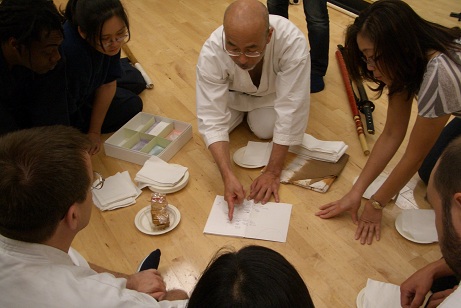
Soke talks to the group about the lineage of the style
When asked, what do you think of…? He would say, “well, Kamiizumi once said…” or “according to Munenori, …”. It was never about himself. He told a lot of stories about the Yagyu family, Kamiizumi Nobutsuna the founder, and others. In essence, he was telling us about the folklore and traditions of the style. He paid respect to the past and the ancestors of the style. It wasn’t about the technical stuff: how to cut, how to walk, etc… But the mystical stuff, the stories, the adventures. We got into an interesting talk about Yagyu Jubei and his eye-patch. The legend, the myth. We talked about Tokugawa Ieyasu and Yagyu Munenori, and their relationship. He told us about Kamiizumi and his meeting with Yagyu Muneyoshi (Sekishusai). Destiny. This was what turned a dry art into a living tradition. And that is what Daniel was referring to when he commented on Soke’s passion and love of his Ryuha. Not just sword-fighting, but to be a part of a living tradition, to be part of the myth, to be part of the legend. And it was evident from what Sensei said and alluded to, that he felt honoured to be a part of that tradition and to carry it on. And on our part, we felt deeply honoured and grateful that Kajitsuka Sensei would come all the way across the world to share his passion with us. It was truly a great and moving experience.
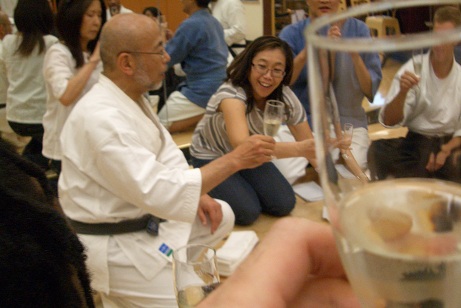
A toast and a big thank you to Kajitsuka Sensei for a wonderful seminar
